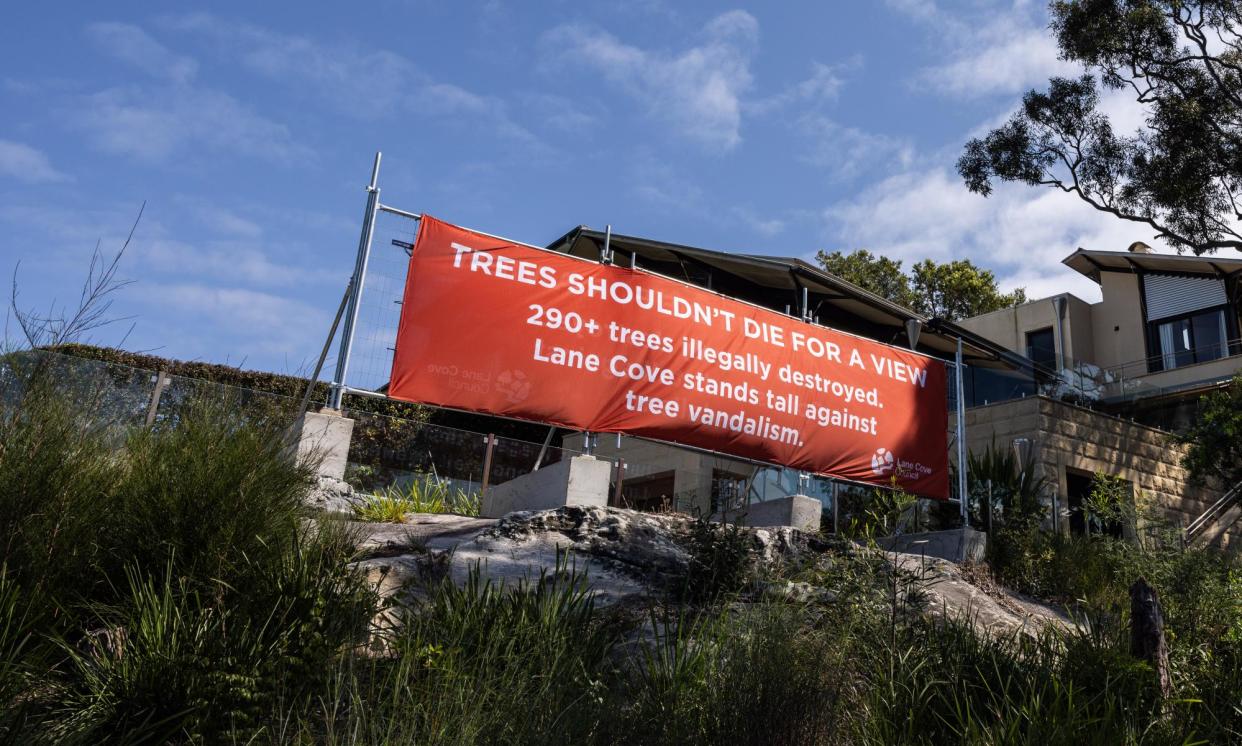Huge banner scuppers prime Sydney Harbour view gained by killing of 300 trees

A huge banner has been erected to block prized views of Sydney Harbour created after almost 300 trees were illegally killed as councils across New South Wales seek ways to stop the damaging practice.
The double-sided red sign, spanning seven metres, was installed at the Longueville site where more than 290 trees were chopped down a year ago in what the council described as “the worst act of environmental vandalism”.
The mayor of Lane Cove, Scott Bennison, said the banner would obscure any advantageous harbour outlook that was gained by destroying the trees – many of them mature specimens of eucalypts, banksia and casuarina.
“It also sends a strong message to the wider community that we will not tolerate the illegal removal of trees in Lane Cove,” he said.
“To see such disregard for our natural environment, all for the sake of a view of the harbour, is offensive.”
But tree vandalism is an “enormous problem” that stretches far beyond the sparkling Sydney Harbour, according to Dr Gregory Moore, a research associate at University of Melbourne.
Councils are prosecuting those found to be engaging in the practice, which is increasing across the country, but fines are baked into the calculation for many, he said.
“They may get a fine. Sometimes it’s a few thousand dollars. Rarely, it gets up into the tens of thousands of dollars. That’s very rare,” Moore said.
“They consider that just part of the cost of doing business.”
Tree vandalism affects the natural environment, leads to a loss of critical habitat and worsens urban heat islands, creating dangerous environments for humans, he said.
“What you’re doing is you’re removing growth many times of decades and centuries. They’ve matured, they’re fixing carbon, they’re cleaning air, they’re cooling,” Moore said.
“It’s essentially stealing from a future generation.”
Councils in NSW can issue on-the-spot fines of up to $3,000 for individuals and $6,000 for companies, and higher fines can be sought through the courts. But the Lane Cove mayor has joined with others calling for harsher penalties.
“We would welcome any changes that would make a potential offender think twice about engaging in illegal practices,” Bennison said.
In mid-2023, 265 trees were killed with poison, drills and chainsaws in Castle Cove in what the Willoughby council suspected was someone’s attempt to gain better ocean views. A $10,000 reward was offered to track down those responsible.
In February this year, Mosman council staff found nine fig trees in the area had been drilled along the Balmoral foreshore.
In June, the Mosman mayor, Carolyn Corrigan, said she and other local government leaders had asked the state government to increase penalties and, in particularly egregious cases, consider jail terms for tree vandalism.
“The government states that before any policy change is considered, consultation with councils will continue, but … I remain concerned that the destruction of our much-loved tree canopy will continue,” she said.
The NSW planning and public spaces minister, Paul Scully, said the government was working on “alternate approaches” and councils’ abilities to successfully enforce laws.
“One of the challenges to overcome is the capacity of councils to collect suitable evidence for successful prosecutions,” he said.
“Larger fines mean nothing if you don’t have suitable tools to prosecute people.”
Workers are monitoring the Longueville site and hoping vegetation can naturally regenerate. When the trees are of sufficient height, the sign will be removed.


